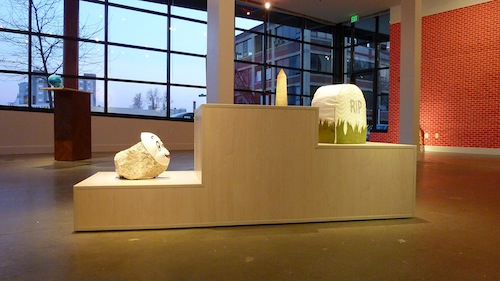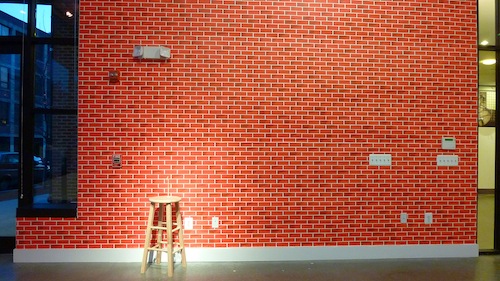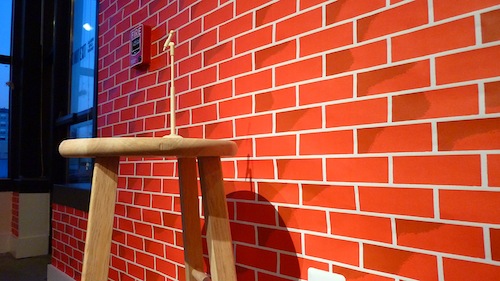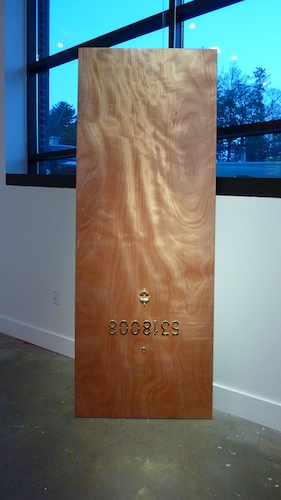The work presented in “Jumbo Mumbo,” Seth Crawford’s solo exhibition at Gallery CA, is hilarious and abrasive. It’s funny like purchasing a fake nose at a novelty store only to learn that the soft formed plastic is lined with sandpaper. In fact, that’s exactly the kind of object one might expect to be included among the eight works, perhaps balanced on its tip – evoking an homage to Meret Oppenheim’s fur-lined teacup.
It is precisely this balance between silly and dark humor and smart and stupid ideas that make Crawford’s work complex. These sculptures and installations speak in a vernacular of common symbols and materials, but twist and invert the expected outcomes to create absurdist moments of laughter and discomfort. The titles of the works further this dynamic, alternately obscuring the content of the artwork with ten-dollar words or simply just explaining the obvious with word-play. I find the relationship between words and symbols in these works to be complicated, and for this reason I’m going to refrain from using the titles here. I don’t think it would enhance the reader’s understanding of the work, and might occasionally detract. However, the title of the exhibition begs discussion.
Like most of the forms Crawford’s sculptures assume, the title of the show, “Jumbo Mumbo” is a twist on familiar and often misunderstood ideas, in this case the phrase “Mumbo Jumbo.” But you knew that already. It’s obvious. It’s exactly that sort of assumption of familiarity that the artist relies on throughout the exhibition. The original phrase is loaded with negative cultural associations. “Mumbo Jumbo” has its origins in the colonialism of European explorers in Africa who defined spiritual ritual as “black magic.” Moreover, it’s a term of dismissal and derision, branding a thing not to be taken seriously. Flipping the placement of the two words seems to negate that meaning, but doesn’t quite. The words are inverted, but the phrase is not necessarily transformed. The connotation the title lends the show is accurate to the work, suggesting a skeptic approach to mysticism, idol-ism and the value we put into objects, particularly art objects.
Magic and spiritualism are apparently present in several of the works. Mounted to a wall is a white-wood tabletop that might be found in any suburban home. It is cleanly decorated with a stripe inset from the perimeter, and then within the ring, a similar set of stripes that create a pentagram. At the five points of the star are mounted store-bought white glazed-ceramic hand-sculptures gesturing “flipping the bird”, “thumbs up” and “okay.” Strung through and between the hands are a network of “friendship bracelets” of colorful braided embroidery thread. As a former small-town mullet-haired mall-rat classic rocker, I recognize the literal and material symbols that compose the piece. It’s a beautiful mandala of de-fanged household occultism. Looking at it, I get the feeling…. Is it possible to be mocked by a sculpture? I think it is, and in my eyes that’s the true magic of the piece.
Another work connected to this theme features a winner’s podium (i.e. athletic medal ceremony), scaled a bit smaller than expected. Cleanly fabricated with a veneer of laminate flooring common to a kitchen, the stand is home to only two residents. In the second-place position is what appears to be a white quilted pillow transformed with colored felt into a foot-tall grass-skirted headstone that reads “RIP.” Reading the list of works reveals that the “pillow” is a stuffed stand mixer cover – not unlike a tea cozy. In the third place spot is what appears to be an oblong chunk of concrete wearing a children’s Halloween cartoon ghost mask. The mask is directed up towards the empty winner’s spot. I find this piece incredibly sad and yet totally ridiculous. Domestic materials and banal found objects are re-purposed into characters that convey a deep sense of loss while also hinting at a bleakly morbid sense of humor. On this podium, there are no winners, and in fact, the empty primary spot may be telling us there is no Heaven.
Dominating one wall of the gallery is an installation of brilliant simplicity. The wall is covered with long sheets of wallpaper neatly push-pinned in place, transforming it into a monolith of faux-red-brick. Dwarfed well-left of center against the wall is a pre-fab pine stool, inexpensive and easily found at a store like Walmart. A spotlight is aimed at the stool and the object deliberately positioned on its seat: a small, carefully-carved wooden microphone in a stand. Here, the humor found in the rest of this work explicitly becomes about comedy. Against this wall, the gallery has been transformed into a stand-up comedy club. Here we are given opportunity to consider the Artist as an awkward entertainer. The microphone is both precious and insignificant; a communication device rendered weak and lonely by its diminished scale and placement on the stage of the stool.
The established contemporary artist I most strongly connect to Seth Crawford’s work is Tom Friedman: they share a similar sense of craft, detail and creative use of common, symbolically-loaded materials. However, much of Friedman’s work has an opaque quality, as if he’s unwilling to reveal anything personal. While Crawford’s work has a similar “dry” sensibility, his humor and embrace of kitsch take the risk of communicating a strong personality. Yeah. There. I said it. The “K-word.” Like “Mumbo Jumbo”, a misunderstood phrase from an earlier time. Native to Germany, there is no direct translation. The word is understood to mean “something that appeals to popular or lowbrow taste and is often of poor quality.” Today, it could be synonymous with “meme” – as both are (mis-)perceived as quick, under-thought and widely distributed trinkets with the qualities of cheap jokes and temporary concepts. Within a contemporary art context, the word often takes on a pejorative meaning. This originated 74 years ago when Clement Greenberg positioned Kitsch as a combatant of “High Art.” Times have changed. The work in “Jumbo Mumbo” embraces the aesthetic for its possibility and makes a convincing argument that intelligent, thoughtful messages as well as puerile jokes can be communicated through it. Often at the same time.
“Jumbo Mumbo” is presented by the Institute for Contemporary Art (ICA), Baltimore and Gallery CA, located in the City Arts Building at 440 East Oliver Street. The exhibition runs from April 6 to 27. Gallery hours are 12-4pm on weekdays. The artist will be present for an “Old Work Rummage Sale” at the gallery Saturday, April 13 from 10am-4pm.
Ian MacLean Davis is a Baltimore-based artist and instructor.









